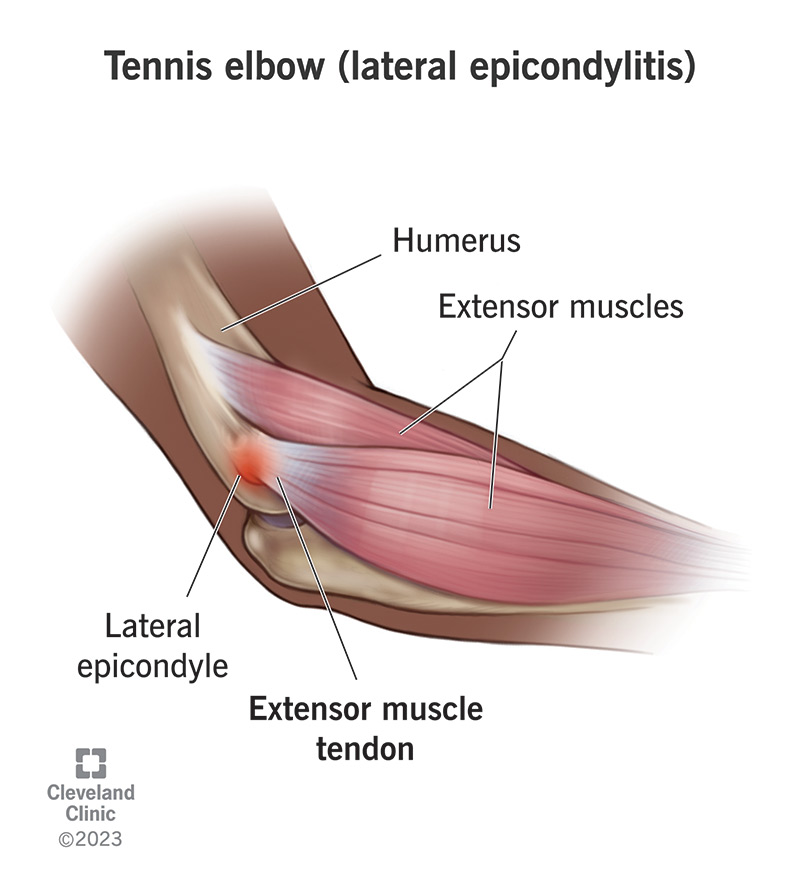Tennis elbow (lateral epicondylitis) is an overuse injury that affects a tendon in your elbow. It happens when you do a repetitive motion like twisting or swinging your lower arm a lot. Most people get better with a few months of nonsurgical treatment and rest.
Advertisement
Cleveland Clinic is a non-profit academic medical center. Advertising on our site helps support our mission. We do not endorse non-Cleveland Clinic products or services. Policy

Tennis elbow (lateral epicondylitis) is a tendon injury that causes pain and inflammation in your elbow. It’s usually a repetitive strain injury.
Advertisement
Cleveland Clinic is a non-profit academic medical center. Advertising on our site helps support our mission. We do not endorse non-Cleveland Clinic products or services. Policy
Repetitive strain injuries happen when you use a part of your body to repeatedly do the same kind of motion so often that it damages your tissue.
Tennis elbow gets its name from being a common injury among tennis players. It happens when you overuse the tendon that connects your forearm muscles to your elbow. The medical term for tennis elbow is lateral epicondylitis. Epicondylitis is inflammation in that tendon. Lateral epicondylitis means the inflammation is on the lateral side. It’s the outside edge when you hold your arms at your sides with your palms facing forward.
Tennis elbow is one of the most common causes of elbow pain. Even though it’s named for tennis, that’s not the most common cause. Experts estimate that more than 9 in 10 people develop it for other reasons.
Any motion that makes you grip or twist and swing your forearm often can cause lateral epicondylitis. Visit a healthcare provider if you have an elbow injury or feel pain that doesn’t get better on its own in a week. Seeing a provider as soon as the pain starts can increase your treatment options. And how well they work.
The most common lateral epicondylitis symptoms include:
Advertisement
You can’t know for sure you have tennis elbow without visiting a healthcare provider for a diagnosis. Lots of people with tennis elbow feel a specific kind of pain in their elbow and arm. The pain usually feels:
You might notice more pain when you use your arm for common motions. It might hurt when you turn a doorknob, open a jar or shake someone’s hand. Your grip may feel weaker in these motions. Even if you’re not using a lot of strength.
Most people develop lateral epicondylitis in their dominant arm. That’s the side you naturally use for most activities. You’re most likely to have tennis elbow in whichever arm you use the most for a repetitive activity. It’s the arm you hold a racket or tools with.
It’s less common, but it’s possible to develop tennis elbow in both arms at the same time.
Any motion or activity that you do too often can trigger tennis elbow. Extra stress from repetitive movements builds up over time. Eventually, that added use and stress on your tendon causes tiny tears. Those lead to symptoms you can feel and notice.
A sudden arm or elbow injury can also cause lateral epicondylitis. But this is less common.
Anyone can develop tennis elbow. But you may be more likely to if you:
Tennis elbow usually doesn’t cause serious complications. If you keep using your injured elbow before your tendon heals, you can increase your chances of rupturing (tearing) it.
A healthcare provider will diagnose tennis elbow with a physical exam and some tests. They’ll examine your injured elbow and ask about your symptoms. Tell your provider when you first noticed pain, stiffness or other symptoms. And if any activities make symptoms better or worse.
Your provider may use some of the following tests to check for damage inside your arm and take pictures of your elbow:
Your provider will suggest treatments to help your tendon heal. The most common treatments include:
Advertisement
Visit a healthcare provider if you think your elbow is injured or you notice any of the following signs:
You should expect to take a break from the physical activities that caused tennis elbow. You may need to stop doing some activities completely, or do them with modifications (like wearing a brace while you work or taking breaks more often).
People almost always make a full recovery from tennis elbow. You should be able to resume all your usual activities once your tendon heals, even if you need surgery.
Tennis elbow can last anywhere from a few months to more than a year. It usually takes around six months to recover, but some people need longer (up to 18 months).
How long it’ll take you to recover depends on a few factors:
Tennis elbow and golfer’s elbow are similar conditions. They’re both repetitive strain injuries caused by overusing your arm and elbow.
Tennis elbow affects the tendon on the outer (lateral) part of your elbow. Golfer’s elbow affects the tendon on the inner (medial) part of your elbow. The medical term for golfer’s elbow is medial epicondylitis.
Advertisement
It’s confusing to learn you have tennis elbow if you’ve never swung a racket in your life. But tennis elbow (lateral epicondylitis) is named for the kinds of arm motions that can irritate and damage a tendon in your elbow. You don’t need to be a Wimbledon contender to have tennis elbow. In fact, most people who have it don’t even play tennis.
You’ll probably need a few months of rest and nonsurgical treatments. This will help your injured tendon heal. Your provider will tell you which treatments will be best for you and how long you’ll need to avoid certain activities or motions.
Advertisement
If an injury puts you on the bench, you want experts by your side. Cleveland Clinic’s sports medicine specialists can get you back in the game.

Last reviewed on 01/15/2024.
Learn more about the Health Library and our editorial process.